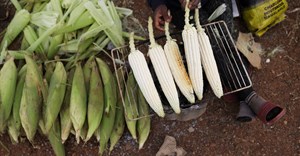A crop munching worm that can fly up to 100 km (60 miles) at night is spreading rapidly across Africa, threatening food production and the livelihoods of millions of farmers already struggling with conflicts and drought, experts said on Friday.

©Mikhail Kochiev via
123RFThe larvae form of Fall armyworm prefers maize, but can feed on more than 80 plant species including rice, sorghum, millet, sugarcane, vegetable crops and cotton, said the United Nations' Food and Agricultural Organization (FAO).
A great challenge to the survival of agriculture in Africa
"There are roughly 35 million hectares of maize planted per year in Africa and if (the worm is) not in all those maize fields now, it will be very soon in the next planting season or so," said Allan Hruska, principal technical coordinator at FAO.
The fields are tended by some 30 million smallholder farmers who depend on maize for food and income, Hruska said.
"Fall armyworm poses a great challenge to the survival of agriculture in Africa," with the potential to put hundreds of millions at risk of hunger, Mark Green, head of the US Agency for International Development told the Thomson Reuters Foundation in a statement.
Disaster area
The invasive species, native to tropical and subtropical regions of the Americas, was first detected in Central and Western Africa in early 2016. It has now spread to virtually all of sub-Saharan Africa, according to an FAO map seen by the Thomson Reuters Foundation. The female moth can lay up to 1,000 eggs in her lifetime.
In December, Malawi declared 20 out of 28 districts disaster areas after an outbreak of Fall armyworm. In Zimbabwe, Fall armyworm destroyed 20% of the country's maize crop last season, according to government figures, at a time when the country was recovering from devastating drought.
Losses in Africa could range from eight to 20 million tonnes in just 12 maize-producing countries alone if the pest is not controlled, and could be more severe in areas already suffering drought and conflict, said Ken Wilson, professor of evolutionary ecology at Lancaster University in England. Drought-affected plants are less able to resist the pests while conflict may prevent farmers from accessing much-needed help, he said.
Fall armyworm here to stay
Farmers in America use genetically modified plants and advanced pesticides to control the pests, but these options may be too expensive and harm the environment and crops.
"The farmers can get pesticides from the government this year, but what happens next year, or the year after that?" said Wafaa El Khoury, technical specialist at the International Fund for Agricultural Development (IFAD) in Rome.
Mixing crops and encouraging natural predators may be more effective, from the experience of smallholder farmers in the Americas, said FAO's Hruska.
But Wilson said Fall armyworm's presence in Africa is irreversible. "It's here to stay and we need to develop strategies on how best to manage this pest long-term," he said.
(Editing by Ros Russell)
Read the original article on Thomson Reuters Foundation.











